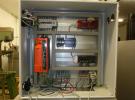Hi, I'm running a labjack UE9 with python and I'm trying to read all 14 AINS at the same time and it's really slow. The following is more or less what I'm doing:
while runwhile == 1:
AINS[0] = AINS[0] + [d.readRegister(0)]
AINS[1] = AINS[1] + [d.readRegister(1)]
AINS[2] = AINS[2] + [d.readRegister(2)]
AINS[3] = AINS[3] + [d.readRegister(3)]
AINS[4] = AINS[4] + [d.readRegister(4)]
AINS[5] = AINS[5] + [d.readRegister(5)]
AINS[6] = AINS[6] + [d.readRegister(6)]
AINS[7] = AINS[7] + [d.readRegister(7)]
AINS[8] = AINS[8] + [d.readRegister(8)]
AINS[9] = AINS[9] + [d.readRegister(9)]
AINS[10] = AINS[10] + [d.readRegister(10)]
AINS[11] = AINS[11] + [d.readRegister(11)]
AINS[12] = AINS[12] + [d.readRegister(12)]
AINS[13] = AINS[13] + [d.readRegister(13)]
if while_ind == 50:
runwhile = 0
while_ind += 1
This approach takes way too much time I feel like. This is my first time using the labjack with python, so I really don't know what I'm doing. Can anyone help me with this? It would be greatly appreciated. Thanks.



.png%3Fitok=PHGBxf6M)


.jpg%3Fitok=B1YcuDFK)
.png%3Fitok=Ybt-OlgU)
Your code is slower since you are performing 14 USB command-response communications instead of grouping multiple commands for less USB communications. Also, analog input readings are 2 registers, so correct addresses when using readRegister are 0 (AIN0), 2 (AIN1), 4 (AIN2), 6 (AIN3), etc.. Since addresses are consecutive, you can use readRegister to read multiple analog inputs for better efficiency:
# Starting register address = 0 (AIN0), read 28 registers (14 AINs)
ainsRead = d.readRegister(addr=0, numReg=28)
for i in range(14):
AINS[i] += ainsRead[i]
Command-response times are documented here:
https://labjack.com/support/datasheets/ue9/operation/command-response
Note that Modbus adds some additional overhead since binary to float conversions are performed on the UE9, and with Feedback the computer performs the float conversions.
I'm having a little trouble finding, I guess, the documentation I'd like for labjack with python. Is there a list somewhere of Labjack python commands?
Also can you explain in a little more detail what the line "ainsRead = d.readRegister(addr=0, numReg=28)" is doing?
Thanks for the help.
You can run this command for ue9 module documentation which details the UE9 class and its methods:
import ue9
help(ue9)
You can also look in the source:
https://github.com/labjack/LabJackPython/blob/master/src/ue9.py
Note that UE9 is a child of the Device class in LabJackPython.py, so the UE9 class has its methods as well. readRegister is documented there or use "help(ue9.UE9.readRegister)".
readRegister uses the Modbus protocol where sensors/functionality are mapped to addresses:
https://labjack.com/support/software/api/modbus/ud-modbus
"ainsRead = d.readRegister(addr=0, numReg=28)" is reading AIN0-AIN13, whose voltages are returned in a list. addr=0 indicates to use starting address 0 which maps to AIN0, and numReg=28 indicates to read 28 registers which is 14 analog inputs. readRegister will convert the register bytes to the float values.
To get more Modbus technical, 1 register is 2-bytes of data. Analog inputs are a 32-bit float value (single) and are 2 registers. They start at address 0, and following analog input channels are offset by 2 since the data type requires 2 registers. So AIN0 = address 0, AIN1 = 2, AIN2 = 4, AIN3 = 6. etc.. For a different example, DIO State reads a single digital I/O state where starting address 6000 is FIO0. It is a 1-register value (1 = high, 0 = low), so consecutive addresses are offset by 1. So FIO1 is 6001, FIO2 is 6002, etc.. The Modbus map is provided in the link above. It's a table with starting addresses and number of registers (Min Regs) to write/read for different functionality.
Also, there is a LabJackPython Modbus quickstart here:
https://labjack.com/support/software/examples/ud/labjackpython/modbus